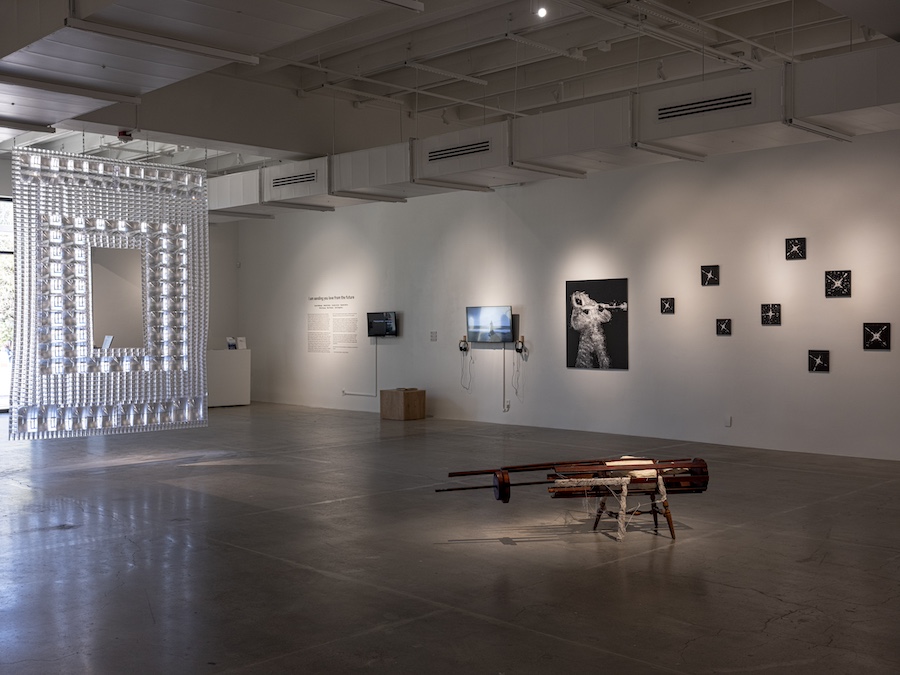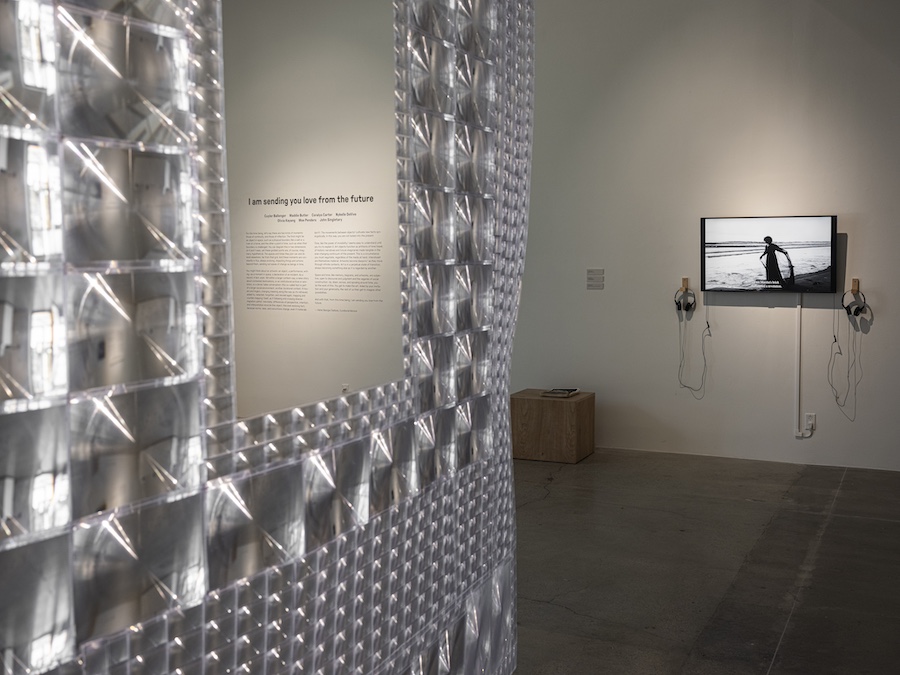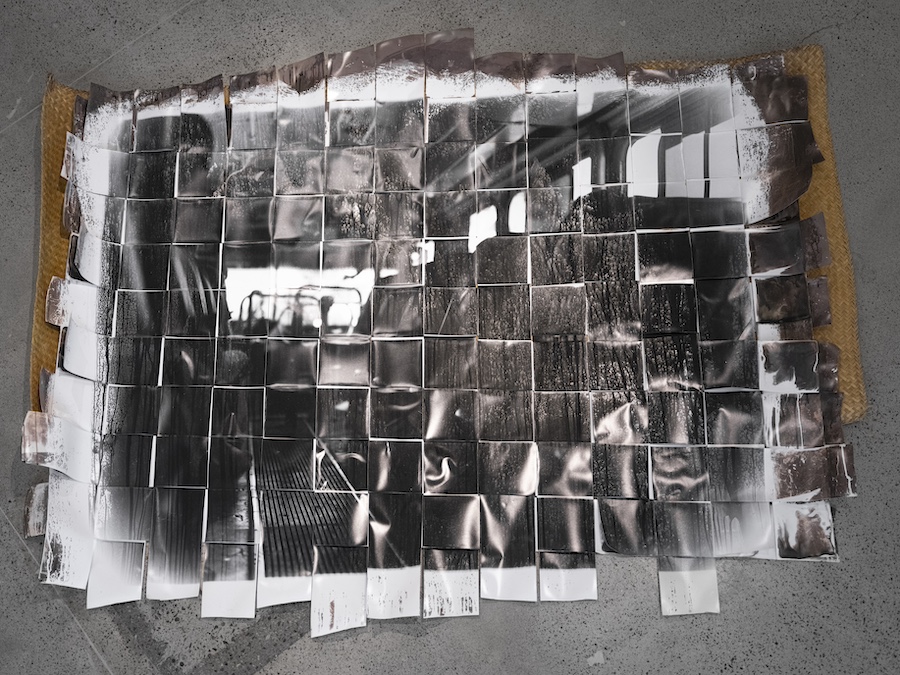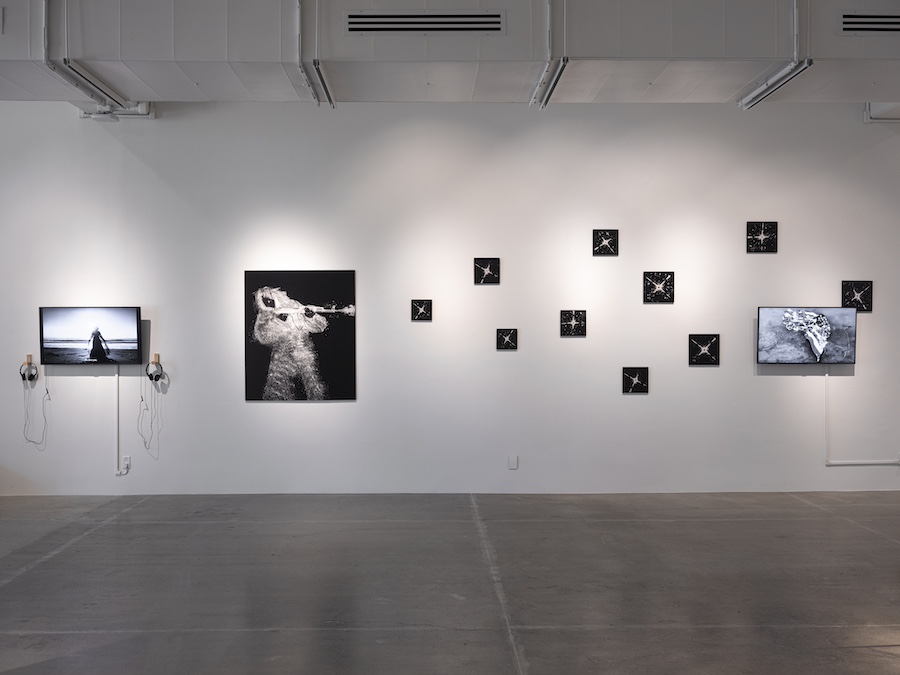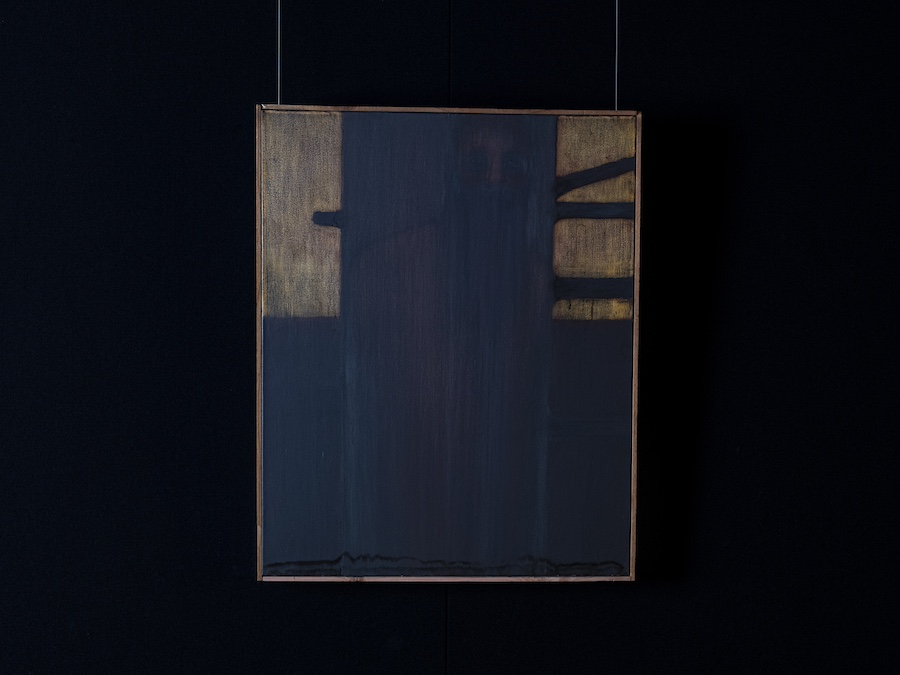I am sending you love from the future
MFA in Visual Arts Preview Exhibition
January 9-February 8, 2025
Participating Artists: Cuyler Ballenger, Maddie Butler, Coralys Carter, Nykelle DeVivo, Olivia Kayang, Moe Penders, John Singletary
Curatorial Advisor: Irene Georgia Tsatsos
The MFA in Visual Arts Preview Exhibition is an annual group exhibition showcasing work by soon-to-graduate MFAs in advance of their final solo thesis shows held in the Spring 2025 quarter. Acclaimed Los Angeles-based curator Irene Georgia Tsatsos worked as the Curatorial Advisor for the 2025 exhibition, where she conducted studio visits with the cohort and devised the exhibition’s title and theme.
For the time being, let’s say there are two kinds of moments: those of continuity, and those of inflection. The first might be an object in space, such as a physical boundary like a wall or a river or a home, and the other a point in time, such as when that boundary is challenged. You can diagram this in two dimensions on X and Y axes, yet these gridded points are, of course, imaginary, hypothetical. The spaces and times they plot can and do exist elsewhere, far from that grid. And these moments are constantly in flux, always evolving, impacting things and actions beyond them, sending out waves of change as beings in time.
You might think about an artwork—an object, a performance, writing—as a moment in space, a declaration of an incident. As a record. A fact, even. Yet within a larger context—say, a news story about contested destinations, or an institutional archive or exhibition, or a dinner table conversation—this so-called fact is part of a larger social environment, another durational context. It hovers and lingers, changing meaning along the way as it’s retrieved, added to, redacted, forgotten, and revived again, mapping and counter-mapping1 itself, as if following and crossing diverse migration paths2. Inevitably, differences of perspective, intention, and interpretation encircle this object, this ever-evolving fact, because norms, laws, and convictions change, even if materials don’t3. The movements between objects4 cultivate new facts synergistically. In this way, you are not locked into the present.
Time, like the power of invisibility,5 seems easy to understand until you try to explain it. Art objects function as artifacts of time travel, of historic narratives and future imaginaries made tangible in the ever-changing continuum of the present. This is a circumstance you must negotiate, regardless of the media at hand. Interstices6 are themselves material. Artworks become diasporic7 as they move through infinite contexts. Art is in a perpetual state of transition, always becoming something else as it is regarded by another.
Space and time, like memory, diagrams, and artworks, are subjective, open to discourse and judgment and the vagaries of social construction. Up, down, across, and spiraling around time, you do the work of this. You get to make the art. Aided by your invitation and your generosity, the rest of us then get to imagine other possibilities.
And with that, from this time being, I am sending you love from the future.
Images: Installation view, I am sending you love from the future, Mandeville Art Gallery, January 8-February 8, 2025. Photo: Nykelle DeVivo
Except where indicated, all notes quote in-person conversations between the author and the artists at the UCSD MFA studios on May 31, 2024.
1 “Disrupting etymologies . . . counter-mapping.” Moe Penders.
2 “Family history . . . looking at work and migration paths, using images of travel, such as cars and trains.” Cuyler Ballenger.
3 “Convictions change, even if materials don’t.” John Singletary.
4 “Not so much narrative, but transformations. . . . Not about objects, but movement between objects.” Maddie Butler.
5 “Invisibility . . . how to signify presence without an actual replica of the body . . . power between who’s making and who’s looking.” Olivia Kayang.
6 "[I’m] thinking of myself and my family and these interstices.” Coralys Carter.
7 “Black diasporic spirituality . . . spaces to commune with spirit for healing.” Nykelle DeVivo, in conversation via Zoom with the author, June 12, 2024.
Irene Georgia Tsatsos Biography
Irene Georgia Tsatsos is an artist with a daily practice of writing, drawing, and reading, all of which inform works rendered in clay, textiles, plants, and space as well as her work as a contemporary art curator. She is a values-inspired artist and arts professional with experience in program development, leadership, and administrative oversight. Most recently, Tsatsos served as director of exhibition programs and chief curator at the Armory Center for the Arts in Pasadena, California. Previously she was the director of Los Angeles Contemporary Exhibitions, has held positions at the Whitney Museum of American Art and the Getty, and has served on numerous award and programmatic panels. She has published extensively and exhibited modestly. Currently, Tsatsos serves on the boards of directors at Children’s Community School and Feminist Center for Creative Work, where she was the founding chair.
Public Programs
I am sending you love from the future opening celebration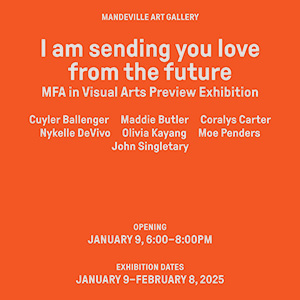
MFA in Visual Arts Preview Exhibition
Thursday, January 9, 2025, 6-8pm, Free
Featuring a tour by exhibiting artists at 6:30pm. Light refreshments provided.
Participating Artists: Cuyler Ballenger, Maddie Butler, Coralys Carter, Nykelle DeVivo, Olivia Kayang, Moe Penders, John Singletary
Curatorial Advisor: Irene Georgia Tsatsos
New Writing Series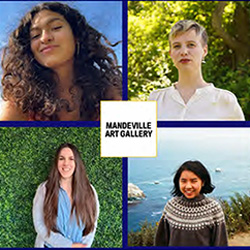
Wednesday, January 15, 2025, 5-6pm, Free
First year MFAs in Writing from the Department of Literature Fiona Martinez, Sarah Mullen, Georgia Wright, and Klytie Xu will read their work in connection with the exhibition I am sending you love from the future.
Organized as part of the Department of Literature's New Writing Series.
Resources
Leer en español
I am sending you love from the future (Les mando amor desde el futuro)
Avance de la exhibición de MFA
9 de enero - 8 de febrero, 2025
Artistas participantes: Cuyler Ballenger, Maddie Butler, Coralys Carter, Nykelle DeVivo, Olivia Kayang, Moe Penders, John Singletary
Asesora curatorial: Irene Georgia Tsatsos
Por ahora, digamos que existen dos tipos de momentos: los de la continuidad y los de la inflexión. El primero podría ser un objeto en el espacio, como un límite físico, es decir una pared o un río o una casa, y el otro un punto en el tiempo, como cuando se reta a ese límite. Se puede hacer un diagrama en dos dimensiones, en los ejes de X y en los de Y, sin embargo, estos puntos cuadriculados son, por supuesto, imaginarios e hipotéticos. Los espacios y tiempos que traman pueden y existen en otro lugar, lejos de esa cuadrícula. Y esos momentos están en un flujo constante, evolucionan siempre, impactando las cosas y las acciones más allá de ellos mismos, enviando ondas de cambio como seres en el tiempo.
Podríamos pensar en una obra de arte—un objeto, una performance, la escritura—como un momento en el espacio, como la declaración de un incidente. Como un registro. Un hecho, incluso. Sin embargo, dentro de un contexto más amplio—digamos, una historia en las noticias acerca de destinos disputados, o de un archivo institucional o de una exhibición, o de una conversación durante una cena—el así llamado hecho es parte de un entorno social más grande, de otro contexto duracional. Planea y persiste, cambiando de significado a lo largo del camino mientras es rescatado, añadido, redactado, olvidado, y vuelto a revivir, mapeando y contra mapeándose1 a sí mismo, como si siguiera y atravesara distintos caminos migratorios2. Inevitablemente, las diferencias de perspectiva, las intenciones y las interpretaciones envuelven a este objeto, a ese hecho en constante evolución, ya que las normas, las leyes y las convicciones cambian, aunque los materiales no lo hagan3. Los movimientos entre los objetos4 cultivan nuevos hechos sinérgicamente. Así, no estamos atrapados en el presente.
El tiempo, como el poder de la invisibilidad,5 parecen fáciles de entender hasta que intentamos explicarlos. Los objetos de arte funcionan como artefactos para viajar en el tiempo, como narrativas históricas y futuros imaginarios hechos tangibles dentro del siempre cambiante continuum del presente. Es una circunstancia que se debe negociar, independientemente del medio que esté a la mano. Los intersticios6 son material por sí mismos. Las obras de arte se vuelven diaspóricas7 mientras se mueven en distintos contextos. El arte está en un estado de transición perpetuo, convirtiéndose siempre en algo más cuando es valorado por el otro.
El espacio y el tiempo, como una memoria, como diagramas y como obras de arte, son subjetivos, están abiertos al discurso y al juicio y a los caprichos de la construcción social. Este trabajo se hace arriba, abajo, a través, y girando en espiral alrededor del tiempo. Así se puede hacer arte. Con la ayuda de su invitación y de su generosidad, el resto de nosotros podemos imaginar otras posibilidades.
Y con eso, por ahora, les mando amor desde el futuro.
